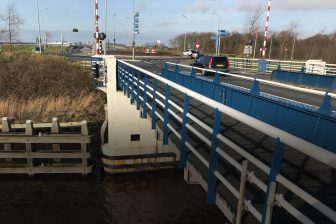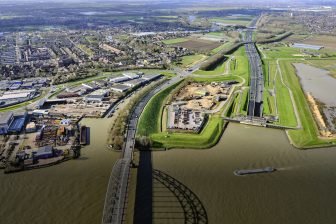Need for Euro-Mediterranean transport systems
2006 FEMIP Conference: Regional integration in the Euro-Mediterranean area through transport systems
Luxembourg, Luxemburg – In accordance with the request of the FEMIP Ministerial Committee at its meeting in Tunis on 25/26 June 2006, the FEMIP Conference provided food for thought on the integrating effects of communications networks and on investment priorities and the financial resources that can be raised from both public and private sector lenders.
Organised jointly by the EIB and the Government of Monaco, under the patronage of HSH The Sovereign Prince, the Conference brought together on 9 and 10 November 2006 some 250 experts and professionals in this sector from the 35 Euro-Mediterranean Partnership countries for an interactive dialogue with Mr Philippe de Fontaine Vive, EIB Vice-President responsible for FEMIP, Mr Jacques Barrot, European Commission Vice-President, and some twenty high-level speakers, including political authorities, CEOs and experts in the field of transport.
The work of the conference, the detailed programme and papers for which can be consulted on the EIB’s website can be summarised as follows:
- 1. The issues involved
During the past 25 years (1980-2004), the partner countries on the southern and eastern shores of the Mediterranean have only benefited to a limited extent from globalisation (1). This situation is due in particular to inadequate regional integration in terms of available infrastructure, and the need for structural reform and modernisation of administrative capacity. Regional integration is therefore vital to provide the southern and eastern Mediterranean partner countries with the resources they need to achieve a sustainable growth rate of 6 to 7% per year in order to meet the challenge of their demography (2), modernise their economies and participate successfully in the globalised economy.Recent economic projections show that high growth rates can be achieved only through “far-reaching regional economic integration”, combining the liberalisation of trade and services with market integration and the implementation of reforms that improve the business climate (3).
From this point of view, the creation of an efficient integrated Euro-Mediterranean transport system is crucial for the development and socioeconomic stability of the region, as emphasised by the first Euro-Mediterranean Transport Ministers’ Conference, held in Marrakesh on 15 December 2005.
- 2. Sectoral policies: objectives and priorities (4)
Since its establishment in October 2002, FEMIP has channelled around EUR 5.5 billion into financing regional infrastructure in the partner countries. Despite concrete results (such as the beginnings of an electricity and gas transmission network in the Mashreq countries and the development of national rail and motorway systems in the Maghreb countries), the partner countries have a long way to go to achieve the infrastructure for regional cooperation required for “South-South” integration. That is why priority must be given to a pragmatic approach focused on the sectors that can be integrated most rapidly, and it is the air and maritime sectors that take priority in the shorter term over the ambitious cross-border terrestrial infrastructure schemes.- 2.1 In terms of tonnage, the maritime sector accounts for almost 90% of international freight trade in the region (5) while 45 ports are capable of supplying the future “maritime superhighways”. These figures are set to double over the next 20 years (6). However, the quality of the freight systems remains inadequate, seriously affecting transport and logistics costs, which account for over 20% of the final value of the transported goods. Policy in this sector must therefore be comprehensive and cover a number of aspects: technical and administrative interoperability, control of the entire logistics chain, the organisation of routes based on hubs and the intermodal connection of ports with their hinterland.
The Conference therefore endorsed the introduction of a multimodal maritime freight system in the Mediterranean which:
- 1. promotes the network concept in the design of new port infrastructure and gives priority to missing interconnections (“maritime superhighways” and access to the hinterland);
- 2. integrates technical and administrative interoperability standards into projects;
- 3. supports private sector projects, the key to liberalising and modernising the sector.
- 1. promoting regulatory convergence and technical cooperation, through encouraging access for the southern and eastern Mediterranean partner countries to agencies specialising in air traffic control and safety;
- 2. supporting the widespread application of international standards;
- 3. encouraging the opening-up of the partner countries’ air transport markets to operators throughout the 35 countries of the Partnership.
2.2 The air transport sector accounts for 90% of international passenger traffic from the southern and eastern Mediterranean partner countries (7), half of which is on routes involving European Union countries. Passenger numbers are expected to more than double over the next 20 years. The air transport sector therefore appears to be one of the instruments of regional integration that should be given priority as far as passenger traffic is concerned: it corresponds to the region’s geographical dimensions, requires proportionally less infrastructure than other means of transport and offers great potential for development (generated by tourism, business traffic and, potentially, by the movement of expatriate populations). Examples of creating the “single sky” (both in Europe and other regions such as the Andean Pact countries and South-East Asia) show that the development and diversification of traffic, as well as the resulting reduction in transport costs, have positive economic and social effects that are clearly perceptible to local public opinion.
The Conference therefore called for the gradual implementation of the “Euro-Mediterranean single sky” by:
- 2.1 In terms of tonnage, the maritime sector accounts for almost 90% of international freight trade in the region (5) while 45 ports are capable of supplying the future “maritime superhighways”. These figures are set to double over the next 20 years (6). However, the quality of the freight systems remains inadequate, seriously affecting transport and logistics costs, which account for over 20% of the final value of the transported goods. Policy in this sector must therefore be comprehensive and cover a number of aspects: technical and administrative interoperability, control of the entire logistics chain, the organisation of routes based on hubs and the intermodal connection of ports with their hinterland.
- 3. Financial area: recommendations
The establishment of an integrated regional transport and logistics system will require substantial investment, which could – on certain conditions examined by the Conference – involve private financing. Official development assistance resources are scarce and must therefore be reserved for projects and used in such ways that offer the best leverage, in terms of either promoting sectoral reform or acting as a catalyst in attracting private sector finance. Accordingly, the 2006 FEMIP Conference recommended that:- 1. the knowledge-based partnership in the Euro-Mediterranean region be further developed, by asking the Union and its Member States to support FEMIP’s research and technical assistance capacities in order to provide a better understanding of the challenges of regional economic development (8) and encourage institutional reform;
- 2. the ability of the international financial institutions to take risks in financing infrastructure be enhanced or even that guarantee structures be established covering the “legislation risk”; and
- 3. the access of private sector or semi-public operators to local currency financing be facilitated; in this connection the Conference encouraged the authorities of the partner countries to consider opening up their financial markets to non-resident borrowers in order to increase their ability to finance infrastructure that is in the public interest in local currency.
- 1. See the FEMISE reports, in particular “10 years after Barcelona: achievements and perspectives” (June 2005), 2005 Annual Report (June 2006) and country profiles (2004-2006).
- 2. According to the most widely accepted estimates, the partner countries must create 2 to 2.5 million new jobs annually over 15 years to hold their current unemployment rates in check.
- 3. Estimate of annual growth resulting from a far-reaching integration process over the period 2005-2015: Algeria: 6.2%; Tunisia: 5.8%; Morocco: 5.7%.
- 4. The reference framework for Euro-Mediterranean transport policy is set out in the Blue Paper “Towards an Integrated Euro-Mediterranean Transport System”, published at end-2004 by the EuroMed Transport Project Forum, and in the Final Report of the “High Level Group on the extension of the trans-European transport network to neighbouring countries”, submitted at end-2005 by Ms Loyola de Palacio.
- 5. The region produces approximately 720 million tonnes of international maritime freight a year (including 270 million tonnes of oil and gas). Of this, intra-Mediterranean trade represents 40% and trade between the Euro-Mediterranean area and the rest of the world 60%.
- 6. And increase eightfold with respect to containerised freight.
- 7. 100 million international passengers a year use the 24 airports in the Euro-Mediterranean area that handle traffic of more than 1 million passengers/year.
- 8. Here the FEMIP studies under way on maritime logistics platforms in the Mediterranean region provide a favourable precedent.
U las zojuist één van de gratis premium artikelen
Onbeperkt lezen? Profiteer nu van de introductieaanbieding voor € 10,- per maand.
Bent u al abonnee?


